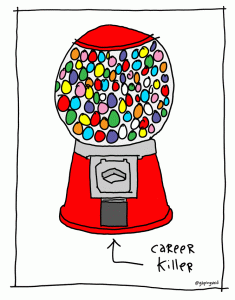 In my last article I talked about providing employees with praise, recognition and meaningful feedback in order to retain staff and build the type of job satisfaction and longevity that creates a sustainable nonprofit.
In my last article I talked about providing employees with praise, recognition and meaningful feedback in order to retain staff and build the type of job satisfaction and longevity that creates a sustainable nonprofit.
For nonprofit fundraisers, the “Great Resignation” was happening long before the pandemic. In fact, per Penelope Burk at Cygnus Applied Research, the average amount of time a fundraiser stays at his or her job is just 16 months.
“Oh, well” you say? “No big deal” you say?
Need I remind you fundraising is a relationship-building business? Relationships happen people-to-people, not people-to-institution.
All that work I’m constantly exhorting you to do to personally nurture, reward and develop bonds with your constituents as you support them on their donor journey matters.
You can’t afford the typical nonprofit staff turnover, and you need to do whatever it takes to make working for you a positive experience.
Lose a Fundraiser; Risk Losing a Donor Relationship
Fundraiser turnover results in the ongoing work of reporting back, asking for feedback and offering praise getting abridged or abandoned altogether. Trust me, this is a genuine real world concern. I work with countless nonprofits, and staff turnover leads to downgraded and lapsed gifts. You may think this won’t happen to you, but it will. When a donor doesn’t get the meaning they need, they drift away to other causes offering them a better return on their engagement. Don’t blame the donors; it’s just human nature to want to feel connected to other human beings.
And don’t make the mistake of thinking you can’t afford to keep your fundraiser by providing a better salary and other benefits, such as additional vacation time. Penelope Burk surveyed 1,700 fundraisers and 8,000 nonprofit chief executives, and found it would cost just $46,650 to keep a good fundraiser happy.
The direct and indirect costs of finding a replacement are $127,650. Hmmn… being pennywise and pound-foolish is not what I would call working smart.
Employee retention costs a fraction of employee recruitment, training and on-the-job learning. So seriously consider what you can do to work a lot smarter by treating your employees like the true treasure they are. As noted in my last article, a decent salary matters. I’m all for offering living wages! But many more things than money are motivators.
It’s time for a closer look at how flexibility in the workplace will help you shine.
Retain More Nonprofit Employees by Being Flexible
A recent guest essay in the New York Times,






















 This week the groundhog told us it’s going to be an early spring!
This week the groundhog told us it’s going to be an early spring!





 From time to time, I host guest posts from professionals with niche expertise. There are just some things others know a lot more about than do I, especially when it comes to technology. Today’s article is one of those, from someone who really understands the ins and outs of text messaging and fundraising. Here’s what he has to say.
From time to time, I host guest posts from professionals with niche expertise. There are just some things others know a lot more about than do I, especially when it comes to technology. Today’s article is one of those, from someone who really understands the ins and outs of text messaging and fundraising. Here’s what he has to say.






 Everyone knows storytelling = good
Everyone knows storytelling = good

 Early in my career I received a piece of fundraising advice that has stuck with me to this day:
Early in my career I received a piece of fundraising advice that has stuck with me to this day:
 I generally counsel nonprofits to
I generally counsel nonprofits to 
 I confess I know virtually zip about artificial intelligence.
I confess I know virtually zip about artificial intelligence. Annual reports don’t have to be dry as dust. In fact, the most effective ones are not financial reports; they’re a story with the donor at the center. And they inspire action.
Annual reports don’t have to be dry as dust. In fact, the most effective ones are not financial reports; they’re a story with the donor at the center. And they inspire action.

 Here’s the deal: When you match people to environments or roles congruent with their skills, knowledge and strengths, they’ll do better.
Here’s the deal: When you match people to environments or roles congruent with their skills, knowledge and strengths, they’ll do better.
 The major gift journey is a synergistic one. You see, it’s both your journey and your donor’s journey.
The major gift journey is a synergistic one. You see, it’s both your journey and your donor’s journey.

 In
In 
